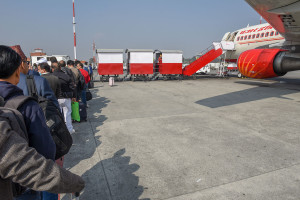Miscellaneous
Ojha-led team finds flowing water in Mars
Twenty-five-year-old Lujendra Ojha recalls his childhood memories in Nepal, when he would gaze curiously at the night sky.
Chahana Sigdel
Twenty-five-year-old Lujendra Ojha recalls his childhood memories in Nepal, when he would gaze curiously at the night sky. “Don’t get into science for money or prestige,” he says. “Get into science if you want to understand genesis, if you want to understand the universe.”
It would be safe to say that his curiosity paid off. On Monday, the National Aeronautics and Space Administration (Nasa) of the United States announced that researchers had found flowing water on Mars, increasing the chances of finding life on the Red Planet. Ojha headed the research team that concluded the existence of flowing water on Mars.
Currently a PhD candidate at the Georgia Institute of Technology in Atlanta, Ojha became a sensation when he discovered possible signs of water as a 21-year-old undergraduate student in 2011.
After the initial discovery, he started working with Alfred McEwen, a planetary geologist at the Univeristy of Arizona. Ecwen runs the Mars Reconnaissance Orbiter’s (MRO) high-resolution camera. The MRO is a spacecraft designed to conduct exploration of the planet from the orbit.
Ojha devised a new technique to analyse photos from the MRO which led to the evidence of water.
On Monday, Ojha and McEwen joined Nasa in a press conference where they confirmed that Martian lines were as wet as suspected. “Our findings strongly support the hypothesis that recurring slope lineae form as a result of contemporary water activity on Mars,” reads the study which was published in the Nature Geosciences Journal. “Determining whether liquid water exists on the Martian surface is central to understanding the hydrologic cycle and potential for extant life on Mars.” Ojha, originally from Kathmandu, moved to the Tucson, Arizona, US, with his family, as a teenager. Some of his family members are scientists, but he says it was not pressure that pushed him into science. It was pure passion.
When he is not busy with research, Ojha likes playing and listening to metal music, “You can be whoever you are, whoever you want,” he says.
Ojha, who is set to graduate next year also spends time studying earthquakes in the Himalayas. In fact, he was last in far-western Nepal a little before the earthquake struck, collecting samples for a study which he says is in its initial phase.
Reflecting on the current situation of science and technology in Nepal, Ojha says there is much to be done. “We need to spend more money in resources like sciences and technology. Provide more funding for people in applied sciences,” says Ojha. “The government of Nepal needs to do more in this field.”




 19.12°C Kathmandu
19.12°C Kathmandu










